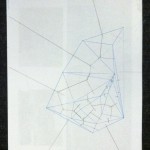Parametric Pencil Picture
I recently developed an interest in Voronoi figures. I have a habit of doodleing them in my Liberal Arts courses. I attempted to put my method into words and have others execute it. Included in the gallery is a drawing of my intent, the instructions, and 3 attempts. My instructions failed to yield a single “correct” drawing.
All three participants faltered under inconcise instructions around line 13. In retrospect, I should have carefully defined terms at the top of the page. Also, it was unclear when to switch colors. One participant, reading the instructions quite closely, didn’t lift the pencil after placing her random points. This resulted in pretty arcs.
Scanned with iPhone in lighting conditions that were only okay.
1. Orient the Letter sized paper in a random orientation. None of these directions reference the orientation
>Memorize steps 2 through 7. This is important. If you forget step 7 you will be unable to see for the rest of your life.
2. Close your eyes
3. Make a dot on the paper
4. Arbitrarily rotate the paper and move your hand to another arbitrary point
5. Make a mark
6. Repeat 9 times
7. Open your eyes
8. Make sure your 9 dots are dark and clear – the dots should have a similar visual prominence to
a black ant. A bit more than a sesame seed.
9. Connect the the dots with the straight edge and the blue pencil provided. Each must connect to at least 3 other nearby dots. If a dot has many neighbors, it should connect to them all. This should form only triangles. If you have a non-triangle, subdivide further. No lines should cross. Try to form the roomiest triangles possible.
10. At this point, you should have a pretty mess of triangles with an outer boundary that is exclusively convex. If you find a concavity, you forgot a line. Subdivide further. Again, making only triangles with lines converging only at your points.
11. From this point forward, lines will cross. This is normal.
12. Bisect all of your line segments with a cute little tick mark using the blue pencil. This mark
should fall exactly in the center of the line segment. You must measure. The tic should have about the prominence of a sesame seed.
13. With the supplied straight edge and a black pencil, extend the ticks into lines. These new lines should be exactly perpendicular to our segments. They should extend out in both directions, terminating only when they hit a previously drawn black segment or the paper edge.
>This means that the first lines will be outrageously long, and the last lines less so. Mark lightly, as they will be shortened later. Each node of the new black mesh should consist of exactly 3 lines. 14. When you have made all of these lines, go back and erase the portions that extend beyond their nodes, and darken that which was not erased.
>The darkened lines should extend between a node and other node or between a node and the paper edge.
15. Ensure the segments are dark and clear.
16. Fin.





Robb, this was a great challenge to pose to your executors. Bravo for an extremely interesting ‘failed experiment’. I am particularly impressed with your diagnostic analysis (‘debugging’), in which you’re able to localize the problem to an ‘error in line 13’; I think this is some of the best reflection that I’ve seen in the class — well beyond the usual “I like all the results”.
I’m very curious what kinds of results you would have obtained if you tried alternate descriptions of the Voronoi diagram, of which there are many. For example, you would have leaned more heavily on the intelligence of your executors, but had significantly simpler explanations overall, if you had simply said, “Draw lines which serve as boundaries between regions, whose interiors are closest to their neighboring site than to any other”.
In my opinion, 9 initial sites may be too many for novice executors of this exercise. I would recommend a smaller number, like 6 or 7.